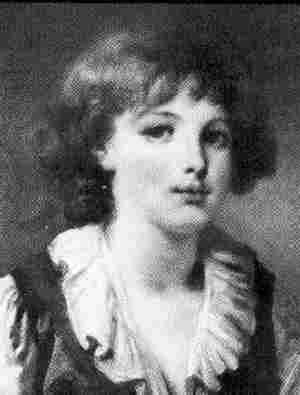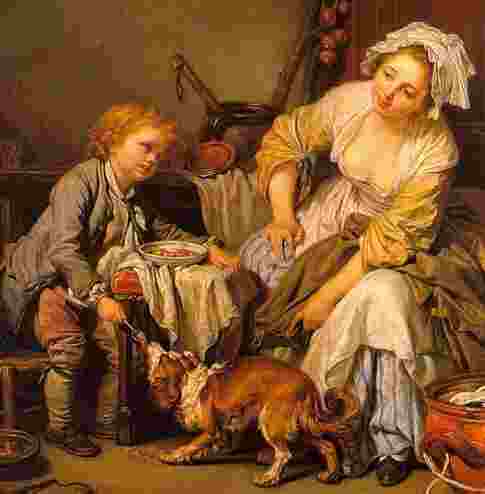
Figure 1.--"Head of a Boy" painted by Greuze about 1780. Note the comfortable looking, open ruffled collar.


Figure 1.--"Head of a Boy" painted by Greuze about 1780. Note the comfortable looking, open ruffled collar. |
The artist Jean-Baptiste Greuze, was a contemporary of Fragonard. He achieved considerable aclaim in pre-Revolutionary France, both for his portaits and genre work. He provides us some wonderful portraits showing how French boys dressed and wore their hair in the 18th century before the Revoluntion. He painted the portraits of some of the luminaries of the Revolution. But in the late 1790s his fortunes declined. Greuze died in poverty and neglect in Napoleonic France. In post-Revolutionary France, his work was ignored and was considered out of fashion.
Jean Baptiste Greuze was a French genre and portrait painter. He was born at
Tournus in Burgandy. I have no information on his childhood or how he was
dressed as a boy.
His father, a master-tiler,
wished to make him an architect, but ended by leaving him free to follow his own
vocation, and sent him to Lyons to study under Gromdon, father-in-law of the musician Grétry. As Gromdon was only a contractor and a picture-dealer and agent, it is hard to see what he could have taught his pupil.
Greuze, however, had
already attained some skill when he came to Paris in 1755, with his picture "Père de famille expliquant la Bible à ses enfants" (A father explaining the Bible to his children). His name was at once proposed to the Academy by Sylvestre, and he was received as an associate. The picture, which was purchased by the celebrated amateur La Live de Jully, was exhibited along with a second painting, "L'aveugle trompé" (The blind man cheated), that same Year. It was a triumph for Greuze. In one day he had become famous in Paris, though he was only 30 years of age. The subject of his first painting was in marked contrast to the Rococo paintings then in vogue in France and attracted
wide attention.

Figure 2.--"The Spoiled Child" (17??) painted by Greuze shows what a boy of modest means might have worn in the mid-18th Century. Notice it is little different than what is father might have worn. |
Greuze like all artists of his day, thought it necessary to travel through
Italy to see the great Renaissance masterpieces. He began his travel in
1755. The trip does not seem to have exerted any
influence on his art. It is true, he brought back from Naples some scènes de moeurs for the exhibition of 1757, but they were Neapolitan only in costume and name.
He soon returned to his true style, paintings of humble and bourgeois life, and
from that moment there began for him a wonderful career of success and good fortune.
A strange change was then taking place in the French mind--a curious variation, so to say, of the moral temperature. Reason, the critical faculty, and the intellect had run riot, and now men felt the need of living the life of the heart. Society, satiated with frivolity and licentiousness, sought repose in a simple, honest life. This it was that made Rousseau's "Julie" and "Emile" so wonderfully popular; it was, in a word, the great moral and religious crisis of the century, it could not but exert an influence on art, and it fell to Greuze to express it in paintings. In this, it is true, he was preceded by an artist much greater than he, J-B-Siméon Chardin whose paintings the "Ecureuse" (1738), the "Pourvoyeuse" the "Bénédicité" (1740) are still masterpieces of the homely French family life.
Greuze went on to paint a large number of moralist genre works such as The wicked son punished, The broken pitcher, The spoiled child, and The father's curse. His work is more or less a painted sermon; he is ever a preacher. In this respect he resembles Hogarth, whom he is undoubtedly imitated as Rousseau imitated Richardson. The success of Greuse was therefore one of the innumerable forms of the 18th Century anglomania.
Greuze was an eminent portraitist. Greuze was well known for family pictures and portraits.Among his most famous portraits are those of the Dauphin, the ill fated son of King Louis XVI, Robespierre, Napoleon, as well as numerous political and artistic figures. Few portraitists painted such a diverse list of subjects. Some of his most striking portraits are the heads of both known and anonymous children and young women. One such portrit is of Paul Stroganoff. This painting made in 1778 is portrait of Paul as a 6-year old boy. It is remarkable by the black background from which the boy's hair slowly appears and the opposition of the full of light face and white shirt.
Over praised in his lifetime, and always popular (on account of his theatrical display and is moralizing literary painting), this artist fully merited his reputation. Though his style was a false one, he was a brilliant master of it. He represents, perhaps, the bourgeois ideal of art and morality. Of the intellectual movement that produced the plays of Diderot, Sedaine, and Mercier, the comic opera of Grétry and Montigny, his work is all that survives to-day. And as a painter of expressive heads, especially of children and young girls, he has left a number of specimens that display the highest artistic gifts. His "Sophie Arnould" (London, Wallace Gallery) and his "Portrait d'inconnue" (Van Horne collection, Montreal, Canada) are among the most beautiful portraits of women produced by the French School.
He painted the portraits of some of the luminaries of the Revolution. But in the late 179os his fortunes declined. Greuze died in poverty and neglect in Napoleonic France. In post-Revolutionary France, his work was ignored and was considered out of fashion.
Many of Greuze's most brilliant portraits are head and shoulder portraits, thus limiting the display of fashion trends. They do provide details on jackets and collars. "Head of a Boy" painted about 1780 shows a boy wearing an open ruffled collar. The image is not clear, but the boy appaers to be wearing some sort of sleevless vest over a blouse. At the time the sleleton suit was emerging as the mpst fashionable attire for a boy. Such open collars were often worn with early skeleton suits, although we have not notice sleleton suits with sleeveless vests. As the portrait focuises on the uppder torso, there is no way of knowing what outfit the boy was wearing. HBC would speculate that the boy comes from an affluent family. In "The Spoiled Child" which HBC does not know the date, the boy wears a closed collar with a cravat, a long jacket and knee breeches. In the "Boy with a Lesson Book" (17??) we see a boy wearing a blouse with almost no collar and a probably a long coat with a double row of buttons.
Greuze also provide a host of detail on hair styles. As he often did portraits emphasizing the upper body, the hair styles of some boys are painted in some detail. "Head of a Boy" appears to show a boy with longish, natuarally curly hair cut well above the shoulders. "The Spoiled Child" show another boy with a similar hair cut, although the boy has much more natuarally curly hair. "Boy with a Lesson Book" (17??) is different. The boy's hair is not naturally curly and less dense than the other images. It is drawn back in the fdront and not cut so it falls to the boys' shoulders.
A contemprary to Greuze was Madame Vigée LeBrun. In fact, some art experts debate as to which of the two did some unidentified portraits. Both authors have left us a wonderful body of work illustrating children's clothing in the 18th century. Greuze alsomdid some genre work. We have not noted this with Madame Bigée LeBrun, but she did do some historical allegories. I do not know if the two artists knew each other. Grueze was quite a bit older than Madame Vigée LeBrun. Unlike Madame Vigée LeBrun, Grueze who was not tainted by royal patronage, stayed in France during the Revolutioin.
Navigate the Boys' Historical Clothing Artist pages:
[Return to the Main arrtist page]
[Chronology]
[Countries]
[Individuals]
[Styles]
Navigate the Boys' Historical Clothing Web Site:
[Introduction]
[Activities]
[Bibliographies]
[Biographies]
[Chronology]
[Clothing styles]
[Countries]
[Contributions]
[FAQs]
[French glossary]
[Satellite sites]
[Tools]
[Boys' Clothing Home]
